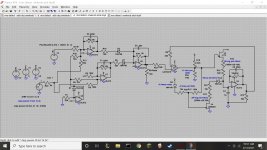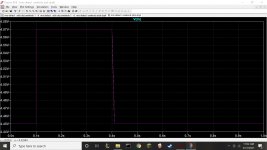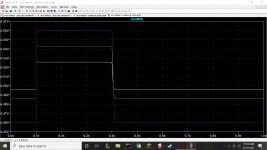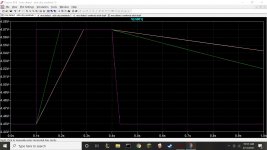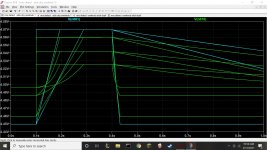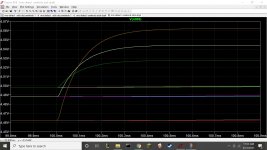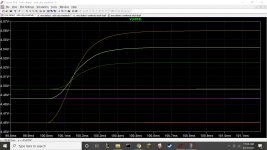I have been designing a guitar (bass) compressor using a That 4305 IC. Most of the design comes from this PDF.
http://www.thatcorp.com/pedals/4316 Battery-Powered One Knob Squeezer.pdf
I added a variable attack/decay cct.
In the sim (THAT provides spice models for these chips) the side chain (control voltage ) depends on the order of the 2 blocks, ie. attack,decay (with a control for each) and treshold/ratio/gain (which is controlled by "one knob").
What I would like is opinions on which way is better. Pics to follow
http://www.thatcorp.com/pedals/4316 Battery-Powered One Knob Squeezer.pdf
I added a variable attack/decay cct.
In the sim (THAT provides spice models for these chips) the side chain (control voltage ) depends on the order of the 2 blocks, ie. attack,decay (with a control for each) and treshold/ratio/gain (which is controlled by "one knob").
What I would like is opinions on which way is better. Pics to follow
The circuit and the input signal. The input signal comes from the RMS detector and is "DC"ish. ("fast DC"?) The first part is the tresh/ratio/makeup (TRM) circuit, then r23 starts the attck/decay (AD) cct.
Attachments
Last edited:
Heres the 2 ccts daisey chained. First is TRM then AD, second is AD first then the TRM. this is the negative control voltage for the VCA. The higher this voltage the more compression you have (6mv/db). so the max compression shown (100mv) is around 17db. (I set the input to 120mv=20db)
Attachments
Last edited:
Actually I was surprised theres so much difference and still not sure why. Any insight would help. Is it a soft knee thing? But the main reason for the post is to ask opinions on what people think the subjective difference might be. What will sound better? If I dont burn out on this project (more complicated then I figured, the number of types and variations of compressor circuits can be overwhelming.) before I get there, I might try both ways and make some sound files.
thanks for clearing up the acronym!
a quick peruse of the link to the THAT chip and it's comparison to the old DBX 163 invoked fond memories of the stereo linked 163's i used to use for vocal comp on a stereo subgroup when live mixing...as i recall it became a balancing act between input level and output "pumping"(gain fluctuation) but the majority of the time they where essentially transparent i.e, not there.
for bass i would explore more on the side of fast attack long release.
a quick peruse of the link to the THAT chip and it's comparison to the old DBX 163 invoked fond memories of the stereo linked 163's i used to use for vocal comp on a stereo subgroup when live mixing...as i recall it became a balancing act between input level and output "pumping"(gain fluctuation) but the majority of the time they where essentially transparent i.e, not there.
for bass i would explore more on the side of fast attack long release.
Trying to make it more generic, so variable attack and decay. Attacks from <1ms to 200ms, decays from 20ms to 3s.
I was thinking about posting the entire design, Sims, testing but there dosnt seem to be much interest.
it's more of a special interest to those into recording or live sound for dynamic control, even i sometime forget that the majority 'round here are about playing back the work of others.
as much as i liked my 163's having access to attack, release, and ratio has become a must for me along with a side chain insert for things like making the comp frequency sensitive.
as a long time user but less of designer i'm still interested in what your doing here, to the point that it's making me wish i where in a better position to advise you. i'll definitely stay tuned!
as much as i liked my 163's having access to attack, release, and ratio has become a must for me along with a side chain insert for things like making the comp frequency sensitive.
as a long time user but less of designer i'm still interested in what your doing here, to the point that it's making me wish i where in a better position to advise you. i'll definitely stay tuned!
Compressors are one of the most popular (and expensive for good ones) bass pedals, guitar also, so I thought there might be some interest. Those That ICs (VCAs and RMS detectors in one IC) are so cheap, you could make a good pedal circuit for $20 in parts. That corp has a guitar pedal page with 5? different designs ready to go or a great place to start. And lots of other design notes and white pages to learn about dynamics processing.
Last edited:
Welcome to, oh, 1988. 😀What I would like is opinions on which way is better. Pics to follow
There's plenty of argument out there on this and on where to take your reference from.
I highly recommend reading the Valve Wizard's Engineer's Thumb for starters. It's feedforward (and discusses the differences)
And have a look at the Fred Nachbaur's Dogzilla, which has feedback compression plus a soft limiter.
Personally, as a player, which way I do compression depends on the sound I'm after. What'd I'd do as a "recording engineer" is likely to be another thing all together.
There's no right or wrong way of doing things.
But its easy to diy a switch to alternate between feedforward and feedback designs. Add some adjustable attack and release times and you have a very versitile compressor.
P.s. My fav atm is an Ibanez BP5 pedal, I realy like the distortion on that one. I use it on everything, dirt cheap is a bonus.
But its easy to diy a switch to alternate between feedforward and feedback designs. Add some adjustable attack and release times and you have a very versitile compressor.
P.s. My fav atm is an Ibanez BP5 pedal, I realy like the distortion on that one. I use it on everything, dirt cheap is a bonus.
Welcome to, oh, 1988. 😀
There's plenty of argument out there on this and on where to take your reference from.
I highly recommend reading the Valve Wizard's Engineer's Thumb for starters. It's feedforward (and discusses the differences)
And have a look at the Fred Nachbaur's Dogzilla, which has feedback compression plus a soft limiter.
Personally, as a player, which way I do compression depends on the sound I'm after. What'd I'd do as a "recording engineer" is likely to be another thing all together.
The That chips and circuits take us into the new millennium. Like there non linear timing cap that has 2 values depending on the speed of the signal, quite clever.
I have looked at many different designs (opto, fet, transconductance, and VCA, both feed forward and back (unfortunately dont have the know how (or cash) for tubes)) of pedal and studio compressors and decided on the That VCA (the classic Blackmer gain stage developed by DBX and used in the iconic SSL buss compressor). The included matching precision RMS detector made it a no brainer for me. And there site includes more info on dynamics processing than Ive seen anywhere else. I would definitely recommend it for anyone interested in building any type of dynamics processor. The compressor is breadboarded and working and am in the process of tweaking as I build the final board. Guess this is a little too specific for a site mostly dedicated to home stereo.
If anyone knows a place more appropriate Ild like to know, thanks.
There's no right or wrong way of doing things.
But its easy to diy a switch to alternate between feedforward and feedback designs. Add some adjustable attack and release times and you have a very versitile compressor.
P.s. My fav atm is an Ibanez BP5 pedal, I realy like the distortion on that one. I use it on everything, dirt cheap is a bonus.
Still thinking about adding features like side chain HPF, mix pot, a meter(or leds), feedback/forward switch, maybe even EQ down the road.
- Home
- Live Sound
- Instruments and Amps
- compressor sidechain sequence, timing before or after treshold,ratio, makeup gain?
